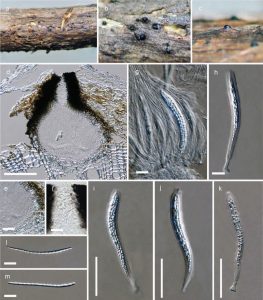Alpestrisphaeria jonesii Ariyawansa, KD Hyde, ZY Liu, sp. nov., Index Fungorum number: IF 552363
Etymology:—Named after the British mycologist, E. B. Gareth Jones, in recognition of his substantial contributions towards the taxonomy of Pleosporales.
Saprobic on dead wood in terrestrial habitats. Sexual morph: Ascomata 280–280 high × 200−260 diam μm, scattered, or clustered in small groups, immersed to erumpent, coriaceous to carbonaceous, black, subglobose, ostiolate. Ostiole slit-like, central, suborbicular, papillate, periphysate, with a pore-like opening. Peridium 20–80 μm wide, thicker near the apex, comprising two cell types of small cells, outer wall composed 2–4 layers of dark brown flattened cells of textura angularis, inner layer 2–3 layers of hyaline flattened cells of textura angularis, both layers thicker near the apex. Hamathecium of 0.6–2.6 μm wide, comprising numerous, filiform, septate, pseudoparaphyses, situated between and above the asci, embedded in a hyaline gelatinous matrix. Asci 120–160 × 10–13 μm (x̅=145×11 μm, n=20), 8-spored, bitunicate, fissitunicate, cylindrical and narrower near the base with furcated pedicel, rounded at the apex, with an ocular chamber. Ascospores 100–140 × 3–5 μm (x̅=125×4 μm, n=40), uniseriate or partially overlapping, filamentous, narrower towards the lower end, hyaline, 10–15- euseptate, separating into two partspores, smooth-walled. Asexual morph: undetermined.
Material examined:—CHINA, Guizhou Province, Guiyang City, Huaxi District, Guizhou Academy of Agricultural Sciences Garden, on dead wood, 1 October 2015, HA Ariyawansa GAAZ 54-1(GZAAS 16-0015!, holotype), ex-type living culture (GZCC 16-0021); ibid. (MFLU!, isotype), living culture, MFLUCC.
Additional material examined:—CHINA, Guizhou Province, Guiyang City, Huaxi District, Guizhou Academy of Agricultural Sciences garden, on dead wood, 12 January 2016, SSN Maharachchikumbura GAAZ 54-2 (GZAAS 16-0016!, paratype), living culture, GZCC 16-0022.
Notes: Thambugala et al. (2015) introduced Alpestrisphaeria to accommodate the monotypic lineage Trematosphaeria terricola which clustered in Lophiostomataceae. Alpestrisphaeria jonesii is compatible with the generic concept of Alpestrisphaeria in having erumpent, coriaceous to carbonaceous, black, subglobose ascomata, slit-like ostioles with periphyses, filiform pseudoparaphyses, fissitunicate asci with an ocular chamber. Alpestrisphaeria jonesii can easily
be differentiated A. terricola by its habitat, cylindrical asci and filamentous, 10–15-euseptate, smooth-walled, hyaline ascospores. Based on the morphology Alpestrisphaeria jonesii shows affinities to the genera such as Ophiobolus and Ophiosphaerella, but can readily be distinguished by the characters of the ascomata and the peridium as well as by DNA sequence data (Ariyawansa et al. 2014; Hyde et al. 2013).

Figure. Alpestrisphaeria jonesii (holotype) a Appearance of ascomata on host specimen. b Close up of ascoma. c Side view of ascoma. d Section of ascoma (TS). e Close up of peridium. f Ostiole, with central periphyses. g Filiform pseudoparaphyses anastomosing between and above the asci. h–k Asci with 8 ascospores with ocular chamber. l–m Filamentous ascospores narrower towards the base. Scale bars: d=100 μm, e, f=40 μm, g, h=80 μm, i, j. k=50 μm, l, m=30 μm.
